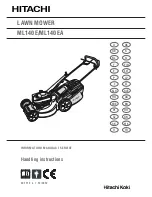
12
13
PRODUCT SAFETY WARNINGS
PRODUCT SAFETY WARNINGS
2. Check the battery charger, cable and plug before
each use. Do not use the battery charger if damaged.
Do not open the battery charger yourself; charger
must be repaired by qualified personnel using original
spare parts.
3. The charger is designed to use a standard household
220-240 V~ 50Hz power source, ensure that the plug
matches the outlet.
4. Never modify the plug in any way, this will reduce the
risk of electric shock.
5. Do not abuse the cord of charger. Never use the cord
for carrying, pulling or unplugging the charger. Keep
cord away from heat, oil, sharp edges or moving
parts. Damaged or entangled cords increase the risk
of electric shock.
6. Make sure the charger cord is situated so that it will
not be stepped on, tripped over or get damaged.
7. Keep the battery charger clean. Contamination can
increase the risk of electric shock.
8. Protect the battery charger from rain and moisture.
If water accesses the battery charger there is an
increased risk of electric shock.
9. Battery will heat up whilst charging. To reduce the risk
of fire, do not operate battery charger on flammable
surfaces such as paper or textiles.
10. The temperature range over which the battery
pack can be charged is typically between 5ºC-
45 ºC. Attempts to charge out with the prescribed
temperature range may automatically be blocked by
the protection circuitry of the battery pack. Longest
life and best performance can be obtained if the
battery pack is charged at room temperature.
11. Disconnect charger from the power supply when not
in use. This will reduce the risk of electric shock or
damage to the charger.
Battery pack
1. Fully charge battery pack before first use.
2. Recharge battery pack immediately when the power
output starts to slow. DO NOT CONTINUE TO USE
PRODUCT WHEN BATTERY LEVEL IS LOW.
3. To prevent serious damage to the battery, charge in
temperatures above 5ºC or below 45ºC. Longest life
and best performance can be achieved when battery
is charged at room temperature.
4. If the battery temperature is above 45ºC it must be
allowed to cool before putting it into the charging
station.
5. To reduce the risk of explosion, ensure the battery
pack is not left in the sun for extended periods of
time and that it is kept away from fire.
6. Do not carry individual battery packs in your pockets
or bag as they could short-circuit against other metal
items.
7. Should a li-ion battery catch fire, ensure to use the
correct fire extinguisher to combat the fire. DO NOT
THROW WATER ON A BURNING LI-ION BATTERY.
Содержание LM G34A
Страница 3: ...4 5 C D G H I J E F K L O P Q R M N 1 2...


































